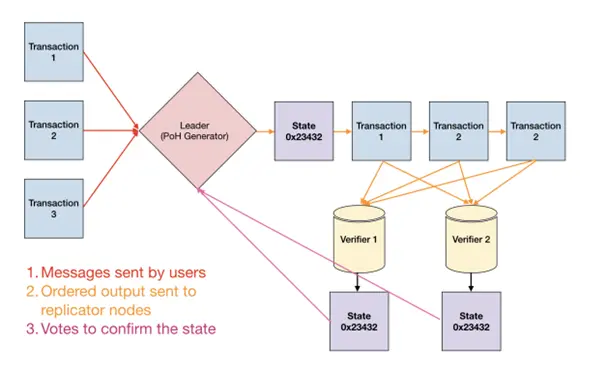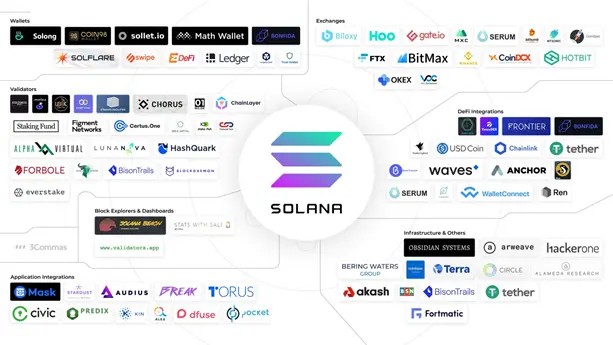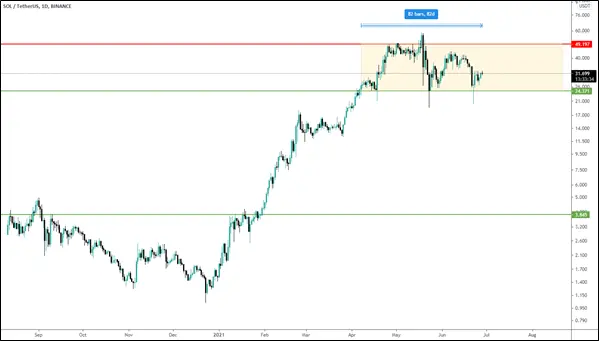What is Solana (SOL)?
- Introduction Solana (SOL)
- Solona Technology
- Solana Use Cases
- Solana’s Ecosystem
- Solana News
- Solana Price
Introduction Solana (SOL)
Solana is a cryptocurrency project that aims to solve the scalability problem of decentralized networks. One of the big problems with decentralized networks like Bitcoin and Ethereum is scalability or the number of transactions per second the network can handle. Suppose everyone wants to pay for their groceries and everyday expenses via the blockchain, it should be possible to handle payments quickly and cheaply.
On networks like Ethereum or Bitcoin, this is currently not possible due to high transaction costs and low transaction speed. This also leads to long waiting times and/or high costs for transactions but also for the users of decentralized apps (dApp) on these networks. So, this is what Solana wants to change.
Solona Technology
The Solana blockchain is currently maintained by 200 nodes that can handle over 50,000 transactions per second. The scalability and the cheap transaction costs of the Solana network are due to the Proof of History protocol used, among other things. This means that no direct confirmation needs to take place on the network because transactions can be approved afterwards.
All transactions are provided with an extra time hash so that a chronological order of transactions can be determined. Figure 1 shows how transactions are processed on the Solana blockchain.

High speed, Low cost
The task of the ‘Leaders’ is to organize all transactions so that they can be verified efficiently. With high-spec computers, such an operation is easy and quick to perform. Once the leader has ordered the transactions, he sends the transactions to the verifiers. The verifiers then check whether the transactions are correct and separately provide confirmation that they are.
Once enough verifiers have given the same confirmation the state of the blockchain is fixed. In this way, a lot of calculations can be done in parallel, and Solana makes fast and cheap transactions possible.
Solana Use Cases
Solana is an open-source smart contract platform that targets the Decentralized Apps (DApps) and Decentralized Finance (DeFi) market. As such, it is a kind of competitor to protocols such as Ethereum, EOS, NEO and Tron. Solana’s goal is to improve scalability so that decentralized apps can function better. This is mainly to make current DeFi protocols run better and be more affordable as currently possible on the other networks.
With the advent of DeFi, the number of transactions made on decentralized networks has increased dramatically. Ethereum has even seen transaction fees of over 30 euros each, in a world where entire DeFi ecosystems must run on these types of blockchains that is just not cost-effective.
The Solana platform, therefore, wants transactions on the network to have a very short processing time at a hugely low cost, and in doing so wants to attract these types of applications to itself. This proposition is not only attracting new projects but also existing projects are making the switch. Solana’s ecosystem is shown below.
Solana’s Ecosystem
As described earlier, Solana focuses on DApps and DeFi projects. This can also be seen in the partners and teams they attract to their ecosystem. Below you can see some of the protocols that are already running on Solana.

The task of the 'Leaders' is to organize all transactions so that they can be verified efficiently. With high-spec computers, such an operation is easy and quick to perform. Once the leader has ordered the transactions, he sends the transactions to the verifiers. The verifiers then check whether the transactions are correct and separately provide confirmation that they are.
Once enough verifiers have given the same confirmation the state of the blockchain is fixed. In this way a lot of calculations can be done in parallel, and Solana makes fast and cheap transactions possible.
Solana News
Since the launch of Solana’s Beta network in March 2020, the platform’s developments have accelerated. Within the Solana ecosystem, many new and existing smart contract developers have been developing their protocols. Even though there is already considerable momentum in the developments of the Solana ecosystem, Solana Labs wants to give the ecosystem an extra push to accelerate its growth.
In a private token sale, Solana Labs managed to raise a whopping $314.15 million. This funding will allow Solana Labs to bring in the right partners and capital. Furthermore, it also ensures that the development and launch of new DeFi or Web3 projects can be accelerated across the ecosystem.
Solana Price

Looking at the chart of SOL/USDT we can draw a quick and simple conclusion.
After a long upward trend, the price of Solana has entered a consolidating phase. Two crucial price levels to keep an eye on are $49.19 and $24.37. If the price moves between these two values, the consolidation period is still intact. A breakout of either will determine which trend Solana will enter in the coming period.
For now, it is important to conclude that a consolidating phase after an upward trend indicates a gathering of strength before the trend can continue. This is not a guarantee, so it is wise to keep an eye on both the upside value of $49.19 and the downside value of $24.37.
Receive our newsletter to stay on top of the crypto market.


